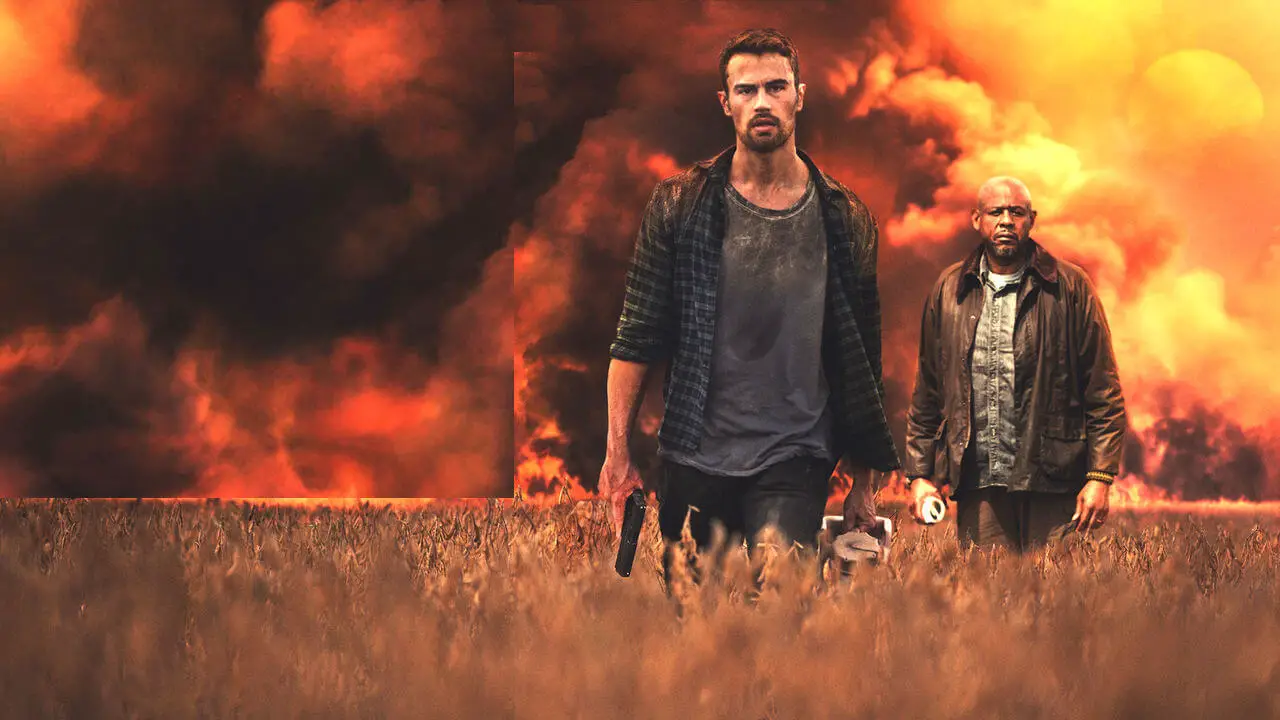The best way I can explain my experience watching “How It Ends” is that I had to apologize every 10 minutes to my friends for inviting them to watch this movie with me. During the two-hour-long Netflix Original, the two most frequently asked questions by my companions and me were, “How much longer does this last?” and, “What the f is going on?”
“How It Ends” is best described as a stir-fry of action disaster clichés, seasoned with extra toxic masculinity, generously sprinkled with plot holes and plated with awkward performance.
Meet the leading man Will Younger (Theo James), an ordinary guy working at a law firm in Seattle. After finding out that his girlfriend (Kat Graham) is pregnant, Younger flies to Chicago to ask for the blessing of his future father-in-law, Tom Sutherland (Forest Whitaker). While Younger is in Chicago, a mysterious natural disaster erupts on the West Coast, cutting off all communication and power in the country. Together, Younger and his father-in-law embark on a journey to Seattle to find his girlfriend.
The premise sounds decent, so what went wrong? Let me break it down for you. First and foremost, “How It Ends” is a 2018 film full of outdated ideas of masculinity.
Sutherland is the epitome of the masculine man. He is a wealthy ex-marine who drives a Cadillac and owns an extensive gun collection. On the other hand, Younger is posited as an average office worker whose normality makes him a lesser man compared to his father-in-law.
When Younger enters Sutherland’s huge and beautiful apartment in Chicago, Sutherland doesn’t invite him to sit in the living room but tells him to go help in the kitchen. The scene caught my attention because it is supposed to convey that Sutherland doesn’t approve of Younger, which is why he exiles Younger from the masculine space (the living room) to the feminine space (the kitchen). The movie frames helping in the kitchen as degrading, as opposed to something a man would be happy to do.
During dinner, Sutherland questions Younger’s ability to provide for his daughter. Although a lawyer’s earnings would seem to be more than enough by most people’s standards, Sutherland perceives Younger’s income as inadequate compared to his own wealth.
The contrast between Younger and his father-in-law tacitly emasculates Younger. Sutherland sits in the living room while Younger helps in the kitchen. Sutherland takes pride in being a breadwinner to an extent that Younger cannot equal. Within the first 20 minutes of the film, “How It Ends” had already disappointed me with its use of regressive gender codes.
As the movie goes on, Younger keeps getting shamed for not being a “real man.” He is bullied by thugs, he struggles to load a gun because he has never handled a firearm before and he constantly needs Sutherland to come to his rescue — he is even called a “faggot” by a mugger.
In comparison, Sutherland never hesitates to pull out his gun, he talks a solider into bending the rules for him by mentioning his military status and he tries to lift heavy gasoline with broken ribs without asking for help from someone standing three feet away.
“How It Ends” seems to uphold the idea that the ultimate man practices violence, breaks the rules when it suits them and never asks for help. The film reinforces an unattainable standard of masculinity according to which a man who drives an economy car and who prefers to use his words over his fists is weak and inferior.
Such ridiculous standards are somehow achieved by Younger, who becomes an expert marksman with fast-and-furious level driving skills, even though a week prior to that he had never touched a gun, and probably spent most of his car rides stuck in Seattle traffic.
The transformation from a bloke on the street to a cold-blooded killer is a common character arc in action disaster movies, since violence is often necessary for self-defense. However, such transformation is not always executed as poorly as in “How It Ends.”
For example, at the end of the zombie-apocalypse movie “28 Days Later” (actual spoiler alert), Jim the bicycle courier (Cillian Murphy) massacres a house full of people. Jim’s violence doesn’t serve to glorify his physical prowess, instead it repulses the audience and confronts them with the ugly side of humanity.
However, in “How It Ends,” Younger and Sutherland’s acts of violence serve no other purpose than to testify to their superior masculinity. The film frames the ability to shoot people in the face at a moment’s notice as highly desirable.
Other than its problematic gender values, “How It Ends” also doesn’t answer the most important question posed at the beginning of the film — what caused the apocalyptic natural disaster? There are a few lines here and there mentioning conspiracy theories but they are never fully explained.
Usually, the main character will uncover the shocking secret, but all Younger does is firmly reject the conspiracy theories without providing an alternative explanation. It’s as if the conspiracy theories were only part of the film because the director and screenwriter wanted to include every action movie trope they could think of.
The plot never unfolds organically, the whole film plays like checking off a long list of clichés. Other clichés that “How It Ends” checks off includes birds flying ominously; fighter jets soaring past windows; a cringey heart-to-heart talk between Younger and Sutherland; someone being mortally wounded but continuing to fight until finally dying; a misfit teenaged girl; a woman crying while the men watch stoically; hitchhiking; a love triangle; an awful sex scene; car chases and explosions.
Because the film tries to cram in so much, the story is rushed and undeveloped, and because the story is undeveloped, the movie feels confusing and boring.
There is nothing noteworthy about the soundtrack or choreography. The performance is overall lackluster. Whitaker looks like he hasn’t gotten a good night of sleep before he steps into the role of Sutherland. James’ portrayal of Younger is decent but far from excellent.
“How It Ends” also has some glaring logical inconsistencies. At one point, a car flips over, rolls around several times and explodes in flames as a result of being shot in the tire.
Finally, for a movie named “How It Ends,” I expected a surprising or interesting ending. I was disappointed, again. Overall, “How It Ends” is a movie that deserves its 5.1/10 rating on IMDB. Personally, I would not recommend it to anyone.

















